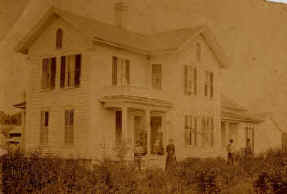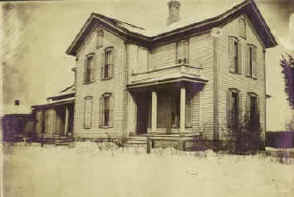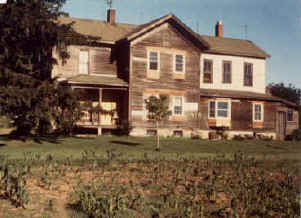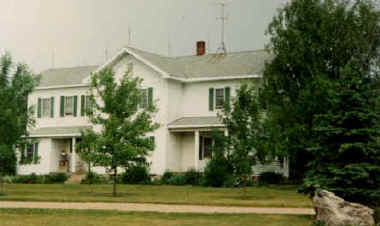Click on pictures to enlarge and read caption.THE WHITE FARM HOUSEIn 1857, when George F.
Porter was 25 and two years after he married Delilah Champlin, he bought 80
acres of land in Chester Township, Ottawa County, northwest of Grand Rapids,
Michigan (source: 1923 Porter Family History). To quote from the history,
written by George’s widow, Mary Ann, “by courage and tireless industry [he]
created this piece of wilderness into a beautiful farm home.” In 1861 a home he had
built on the property was ready for the family to move into. If we reconstruct
correctly, at that time two babies had already been born and had died, Eugene
was just a baby, and Delilah may or may not have been pregnant with Edmond, who
would be born (and die) the following year. George and his family
lived in that frame farm house for four decades. There he raised food to feed
his family, including enough to store through the long winters. There he
watched six of his children take their first steps and say their first
words—and there he watch four more of his children die in infancy. In 1882, he
watched Delilah herself die at the age of 43. A year and a half later, he
brought home a new wife for himself, mistress for the home, At the time of his death
in 1908, the house went out of the family. Though it would be quite sadly
neglected for the next six decades,
today it is resplendent in white aluminum siding and is again the center of a
thriving family farming operation. On a “family heritage
tour” in late June, 1992, great-great-granddaughters Esther Gross and Dottie
Hoppe and Dottie’s daughter and son-in-law, Rachel and Tavi Rendón, stopped at
the farm house on Truman Road and introduced themselves (“Our
great-great-grandfather built this house”). They were warmly welcomed by Fred
and Sue Van Oeffelin, the current owners.
The Van Oeffelins, who
now run the farm as a successful hog-raising operation, were very interested in
the history and the builder of the house. They recounted that Ford Porter had
stopped by at some time and introduced himself (Fred referred to him as “the
evangelist” and kept saying, “He really loved the Lord”). Ford recounted how
his father had built the house, that he had been born there, and had lived
there until he was eight or nine.[1]
The Gentz family who
bought the house in 1908 apparently did little or nothing over the years to
keep it up (it is assumed they were not able to financially?). The Van
Oeffelins recounted that when they purchased the home in 1968, it had never had a second coat of paint and
still had no indoor plumbing. Over the years they have added bathrooms and
redecorated the place, very tastefully and in harmony with its origins. In the
early 1980s they did the whole outside in white aluminum siding. It is now
stately and beautiful; George would be duly impressed—and probably amazed at
the condition of his house after 150 years! Sue Van Oeffelin
graciously took the impromptu guests on a tour of the home, including the
upstairs. It seems likely that all of George’s children except Adelbert,
Edmond, and Eugene were born in the house and that Elbert, Edith, Effie May,
Delilah herself, and baby Earl from Being in the home with
such an ancestral history was a great privilege and pleasure. In 2002 Esther
Gross along with husband Fred drove by the house once more, and it appeared the
same as it had ten years earlier.
2014: In the years since that first encounter with the Van Oeffelins in 1992, my sister and I, as well as many other members of our families, have had the privilege of visiting the white house again and of again enjoying a welcome and hospitality from the Van Oeffelins. [1] Van Oeffelin also reported that Ford said his father then built the brick house on 16th street and moved the family there. Members of the current family feel unsure of that account because it doesn’t fit with other information and impressions they have had of the origins of the brick farm house. For more specifics on this, see notes with write-up about the brick house. Perhaps further research will answer some of these questions. |



